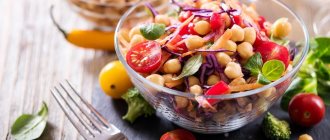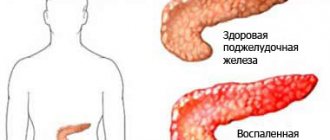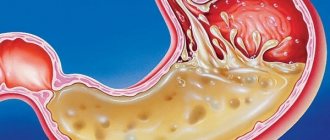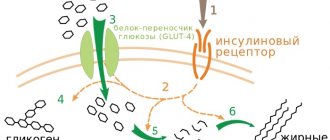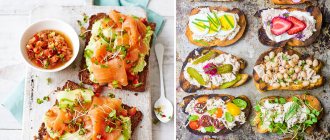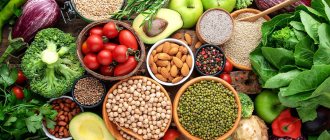Diet for gastrointestinal diseases* is an important addition to treatment. Compliance with certain dietary restrictions can significantly improve your well-being, speed up recovery and prevent new relapses of the disease.
The famous nutritionist and therapist M.I. Pevzner developed therapeutic diets intended for people with diseases of the digestive tract1. A specific nutritional regimen should be selected by the attending physician, taking into account the diagnostic results, the stage of the disease, the acidity of gastric juice and the presence of concomitant disorders. Strict dietary restrictions are typical for the acute form of the disease. During the period of remission, nutritional requirements are not so stringent.
“Healthy and harmful foods” for gastrointestinal diseases
Diseases of the gastrointestinal tract are accompanied by inflammation and damage to the mucous membrane, dysfunction of the digestive organs; patients are strictly contraindicated from foods that irritate the mucous membrane of the digestive tract, increase intestinal motility and cause excessive production of gastric juice. Fried foods stimulate bile formation, release carcinogens, and support the inflammatory reaction on the walls of the digestive tract.
It is recommended to completely avoid the following products:
- smoked meats;
- canned food;
- sausages;
- fresh baked goods;
- sauces, marinades;
- fatty meats, especially pork, lamb;
- legumes;
- sour fruits;
- fresh onions and garlic;
- cabbage;
- fatty cheeses.
The correct diet for diseases of the gastrointestinal tract can only be prescribed by a doctor, based on the individual characteristics of your body.
Most likely, he will recommend steaming, boiling or baking food.
The basis of a therapeutic diet for gastrointestinal disorders* is:
- porridges prepared with filtered water or skim milk;
- first courses with vegetable or light meat broth;
- main courses of poultry, veal, sea and river fish;
- vegetable salads, stewed vegetables, mashed potatoes without butter on the side2.
Table No. 5 (Diet for diseases of the liver and gall bladder)
Indications:
1) acute hepatitis and cholecystitis in the recovery stage;
2) chronic hepatitis without exacerbation;
3) cirrhosis of the liver without liver failure;
4) chronic cholecystitis and cholelithiasis without exacerbation. In all cases - without significant diseases of the stomach and intestines.
The purpose of diet No. 5: chemical sparing of the liver in conditions of adequate nutrition, to promote the normalization of liver functions and the activity of the biliary tract, and to improve bile secretion.
General characteristics of diet No. 5: physiologically normal content of proteins and carbohydrates with a slight restriction of fats (mainly refractory). And they exclude products rich in nitrogenous extractives, purines, cholesterol, oxalic acid, essential oils and fat oxidation products that arise during frying. The content of lipotropic substances, fiber, pectins, and liquids is increased. Dishes are prepared boiled, baked, and occasionally stewed. Only stringy meat and fiber-rich vegetables are pureed: flour and vegetables are not sautéed. Very cold dishes are excluded.
Chemical composition and calorie content of dietary table No. 5: carbohydrates - 400-450 g (70-80 g sugar), proteins - 90-100 g (60% animal), fats - 80-90 g (30% vegetable), 11, 7 -12.2 MJ (2800-2900 kcal), sodium chloride - 10 g, free liquid - 1.5-2 l. You can include xylitol and sorbitol (25-40 g).
Diet No. 5: 5 times a day.
Recommended and excluded foods and dishes:
- soups. Vegetables, cereals with vegetable broth, dairy with pasta, fruit, vegetarian borscht and cabbage soup, beetroot soup. Flour and vegetables for dressing are not fried, but dried. And they include: meat, fish and mushroom broths, okroshka, green cabbage soup;
- bread and flour products. Wheat bread from 1st and 2nd grade flour, rye bread from sifted and peeled flour baked yesterday. Baked savory products with boiled meat and fish, cottage cheese, apples. Long-lasting cookies, dry sponge cake. And they include: very fresh bread, puff pastry and pastry, fried pies;
- meat and poultry. Lean or fat-free, without fascia and tendons, poultry without skin. Beef, young lean lamb, pork, rabbit, chicken, turkey. Boiled, baked after boiling, in pieces and chopped. Stuffed cabbage rolls, pilaf with boiled meat. Milk sausages. And they include: fatty varieties, duck, goose, liver, kidneys, brains, smoked meats, most sausages, canned food;
- fish. Low-fat types. Boiled, baked after boiling, in pieces and in the form of quenelles, meatballs, souffle. And they include: fatty species, smoked, salted fish, canned food;
- dairy products. Milk, kefir, acidophilus, yogurt; sour cream - as a seasoning for dishes; semi-fat and low-fat cottage cheese and dishes made from it (casseroles, lazy dumplings, puddings, etc.). Belin dishes. Mild, low-fat cheese. Limit: cream, milk 6% fat, fermented baked milk, sour cream, fatty cottage cheese, salty, fatty cheese;
- eggs. Baked egg white omelette. Up to 1 yolk per day in dishes. If tolerated, use a soft-boiled egg, in the form of an omelet. And they include: hard-boiled and fried eggs. For cholelithiasis - up to ½ yolk per day in dishes;
- cereals. Any dishes made from different cereals, especially buckwheat and oatmeal. Pilaf with dried fruits, carrots, puddings with carrots and cottage cheese, krupeniki. Boiled pasta. And they include: legumes;
- vegetables. Various, raw, boiled, stewed - salads, side dishes, independent dishes. Non-acidic sauerkraut, onions after boiling, green pea puree. And they include: spinach, sorrel, radish, radish, green onions, garlic, mushrooms, pickled vegetables;
- snacks. Fresh vegetable salad with vegetable oil, fruit salads, vinaigrettes, squash caviar, jellied fish (after boiling), soaked, low-fat herring, stuffed fish, seafood salads, boiled fish and meat, doctor's sausage, milk sausage, dietary sausage, low-fat ham. mild, low-fat cheese. And they include: spicy and fatty snacks, canned food, smoked meats, caviar;
- fruits, sweet dishes, sweets. Various fruits and berries (except sour ones) - raw, boiled, baked. Dried fruits. Compotes, jelly, jellies, mousses, sambuca. Meringues, snowballs. Marmalade, non-chocolate candies, marshmallows, honey, jam. Partially replace sugar with xylitol (sorbitol). And they include: chocolate, cream products, ice cream;
- sauces and spices. Sour cream, milk, vegetable, sweet fruit sauces. The flour is not sautéed. Dill, parsley; vanillin, cinnamon. And they include: mustard, pepper, horseradish;
- beverages. Tea, coffee with milk, fruit, berry and vegetable juices, rosehip and wheat bran decoctions. And they include: black coffee, cocoa, cold drinks;
- fats. Butter in its natural form and in dishes, refined vegetable oils. And they include: pork, beef, lamb lard, cooking fats.
Sample diet menu No. 5.
First breakfast: cottage cheese with sugar and sour cream, oatmeal porridge, tea.
Second breakfast: baked apple.
Lunch: vegetarian vegetable soup with vegetable oil, boiled chicken in milk sauce, boiled rice, dried fruit compote.
Afternoon snack: rosehip decoction.
Dinner: boiled fish with white sauce and vegetable broth, mashed potatoes, cheesecake with cottage cheese, tea.
At night - kefir.
Table No. 5A
Indications:
acute hepatitis and cholecystitis in the initial stage, angiocholitis and other lesions of the biliary tract, diseases of the liver and biliary tract in combination with inflammatory gastric and intestinal diseases, or with ulcers of the stomach or duodenum.
The purpose of diet No. 5A: restoration of the functions of the liver and biliary tract, stimulation of bile secretion while simultaneously sparing the intestines and stomach, accumulation of glycogen in the liver.
General characteristics of diet No. 5A: a diet with complete energy value, with sufficient carbohydrates and proteins, with limited consumption of fats and foods rich in nitrogenous extractives, cholesterol, oxalic acid, and coarse fiber.
Chemical composition and calorie content of dietary table No. 5a: Proteins - 80-100 g (60% animal) Fats - 70-80 g (20-25% vegetable) Carbohydrates - 350-400 g (80-90 g sugar) Calories - 2350-2750 kcal Sodium chloride (table salt) - 8 g. Free liquid - 2-2.5 l.
Diet No. 5a: Food is taken 5 times a day, warm.
Recommended and excluded foods and dishes:
- bread and flour products. Dried or yesterday-baked wheat bread, uneaten cookies. And they include: fresh and rye bread, puff pastry and pastry products;
- meat and poultry. Lean and lean beef, turkey, skinless chicken, rabbit - all in the form of a cutlet mass. Allowed to steam or boil. And they include: fatty varieties, duck, game, goose meat, brains, liver, kidneys, smoked meats, sausages, canned food, fried and stewed meat in pieces;
- fish. Boiled, low-fat steamed fish, products in the form of cutlet mass (mashed potatoes, soufflé) from a boiled product, jellied fish in a decoction of vegetables. And they include: fatty types of fish, smoked, stewed, fried, salted, caviar and canned food;
- eggs. Protein steam omelette, 0.5 - 1 yolk per day in other dishes. And they include: all other types of preparation;
- dairy products. Milk (if tolerated), fermented milk drinks, low-fat and non-sour cottage cheese (dishes made from it, but pureed and steamed), sour cream (small amount in main dishes), mild and grated cheese. And they include: fatty and sour cottage cheese, sharp cheese, cream and natural milk for enterocolitis;
- fats. Creamy and refined vegetable products are scarce (limited quantities). And they include: all other fats;
- cereals, pasta and legumes. Milk porridge (1: 1 with water, semolina, mashed rolled oats, buckwheat, boiled rice. Semolina, rice and buckwheat soufflé, boiled vermicelli. And include: pearl barley, millet, barley groats, crumbly porridges, legumes and pasta;
- vegetables. Steamed, or raw and pureed, puree and soufflé. Zucchini and pumpkin should be boiled or stewed in pieces. And they include: radishes, turnips, radishes, cabbage, spinach, sorrel, onions, garlic, mushrooms, as well as salted, pickled and pickled vegetables;
- soups. Milk soups (1:1 with water), vegetarian soups with cereals (vegetables must be pureed), puree soups. You can top it with sour cream or butter. And they include: fish, meat, mushroom broths, as well as soups with undiluted cereals and vegetables;
- fruits, berries and sweets. Sweet and ripe berries and fruits (processed - raw and unprocessed, baked and boiled), jelly, marshmallows, jelly, mousse, marshmallow, honey, jam, sugar. And they include: hard and sour fruits, berries with hard grains, halva, chocolate, sweets with cream and ice cream.
- sauces and spices. On a decoction of vegetables or mucus from cereals, fruits and berries and dairy. And they are excluded: any spices.
- beverages. Tea with milk and lemon, coffee substitute with milk, rosehip infusion, tomato juice, sweet berry and fruit juices. And they exclude: natural coffee, cocoa, carbonated drinks and cold drinks.
Sample diet menu No. 5A:
First breakfast - steamed cottage cheese soufflé, pureed rice porridge with milk and water + tea
Second breakfast - 1 apple, baked with sugar
Lunch - vegetarian pearl barley soup with pureed vegetables, steamed meat cutlets with carrot puree + jelly
Afternoon snack - rosehip decoction
Dinner - steamed fish dumplings, mashed potatoes, semolina casserole with sweet gravy + tea
Before bed - kefir.
Table No. 5P
Indications:
chronic pancreatitis during the recovery period after an exacerbation and outside of an exacerbation.
The purpose of diet No. 5P: to normalize (the function of the pancreas, to provide mechanical and chemical sparing of the stomach and intestines, to reduce the excitability of the gallbladder, to prevent fatty infiltration of the liver and pancreas.
General characteristics of diet No. 5P: a diet with a high protein content, reduced fat and carbohydrates, in particular sugar. Extractive substances, purines, refractory fats, cholesterol, essential oils, coarse fiber are sharply limited. Fried foods are excluded. The amount of vitamins and lipotropic substances has been increased. Dishes are mainly pureed and chopped, boiled in water or steamed, baked. Hot and very cold dishes are excluded.
Chemical composition and calorie content of dietary table No. 5P: proteins - 110-120 g (60-65% animal), fats - 80 g (15-20% vegetable), carbohydrates - 350-400 g (30-40 g sugar); calories - 2600-2700 kcal, 20-30 g of xylitol instead of sugar in sweet dishes, sodium chloride (table salt) - 10 g, free liquid - 1.5 l.
Diet No. 5P: 5-6 times a day.
Recommended and excluded foods and dishes:
- soups. Vegetarian pureed with potatoes, carrots, zucchini, pumpkin; with semolina, oatmeal, buckwheat, rice, noodles. Add 5 g butter or 10 g sour cream. And they include: meat, fish broth, decoction of mushrooms and vegetables, with millet, milk soups, borscht, cabbage soup, cold - okroshka, beetroot soup;
- bread and flour products. Wheat bread made from 1st and 2nd grade flour, dried or yesterday's bread, in the form of crackers. Unsweetened dry cookies. And they include: rye and fresh bread, puff pastry and pastry products;
- meat and poultry. Lean varieties of beef, veal, rabbit, chicken, turkey. The meat is freed from fascia, tendons, and fat; poultry - from the skin. Boiled or steamed. pureed and chopped (cutlets, dumplings, puree, soufflé, beef stroganoff, etc.). Lean chicken, rabbit, veal - in pieces, boiled. And they include: fatty varieties, duck, goose, fried, stewed, smoked meats, sausages, canned food, liver, brains, kidneys;
- fish. Low-fat boiled, in pieces and chopped. Jellied after boiling. And they include: fatty species, fried and stewed, smoked, salted fish, canned fish, caviar;
- dairy products. Mostly low fat. Fresh non-acidic cottage cheese 9% fat and low-fat, calcined in natural form, infusion, steam and baked puddings Milk - if tolerated. Fermented milk drinks. Sour cream and cream - in dishes. The cheese is low-fat and mild. And they include: dairy products with high fat content and the inclusion of sugar;
- eggs. White omelettes from 2 eggs, yolks - limited (up to ½ per day) in dishes. And they include: dishes made from whole eggs, especially hard-boiled, fried;
- cereals. Mashed and semi-viscous porridges made from oatmeal, buckwheat, semolina, rice, boiled in water and half and half with milk. Cereal souffles, puddings with cottage cheese, casseroles. Boiled pasta. And they include: legumes, crumbly porridges, limit pearl barley, barley, corn grits, millet;
- vegetables. Boiled and baked in pureed form. Potatoes, carrots, cauliflower, speckle, zucchini, pumpkin, green peas. And includes: white cabbage, eggplant, radish, turnip, radish, onion, garlic, sorrel, spinach, sweet pepper, mushrooms;
- snacks. And they include;
- fruits, sweet dishes and sweets. Ripe soft, non-acidic fruits and berries, pureed raw; baked apples; pureed compotes from fresh and dried fruits, jellies, mousses with xylitol (sorbitol) or semi-sweet with sugar. And they include: raw unprocessed fruits and berries, grapes, dates, figs, bananas, confectionery, chocolate, jam, ice cream;
- sauces and spices. Dairy; semi-sweet fruit and berry sauces; in a weak vegetable broth. The flour is not sautéed. And they include: meat, fish, mushroom broth, tomato, all spices;
- beverages. Weak tea with lemon, semi-sweet or with xylitol, milk. Rose hip decoction. Fruit and berry juices without sugar, diluted with water, as tolerated. And they include: coffee, cocoa, carbonated and cold drinks, grape juice;
- fats. Butter (30 g), refined vegetable oils (10-15 g) - in dishes. And they include: other fats.
Sample diet menu No. 5P.
First breakfast: boiled meat, oatmeal porridge, tea.
Second breakfast: steamed protein omelet, rosehip decoction.
Lunch: vegetarian soup of chopped vegetables, boiled beef stroganoff, boiled potatoes, compote of pureed dried fruits.
Afternoon snack: sour cream cottage cheese, tea with milk.
Dinner: boiled fish, carrot puree, tea with milk.
At night: kefir.
PS Before switching to a therapeutic diet, be sure to consult your doctor!
VKontakte
Email
What drinks can and cannot be consumed if you have gastrointestinal diseases*?
People with chronic disorders of the digestive system are prohibited from consuming:
- alcohol;
- coffee;
- sweet sparkling water;
- sour juices.
Dairy products rich in bifidobacteria are beneficial, in particular:
- fermented baked milk;
- curdled milk;
- low-fat kefir;
- homemade yogurt3.
Depending on the diagnosed disease, dietary restrictions may vary. Diet plays a primary role in many ways, but may not always be the only method of helping the body. In some cases, a course or lifelong use of medications may be required. Since the gastrointestinal tract is a coordinated system of different organs, a disorder in one of them can provoke a disorder in another. For example, a malfunction of the biliary system can affect the quality of digestion. This happens because bile triggers a cascade of reactions necessary for the production of digestive enzymes. These enzymes are secreted by the pancreas and enter the intestines to help digest food. If bile flows intermittently, then a lack of enzymes may occur. As a result, the body may not receive enough necessary substances from food and experience heaviness after eating, bloating, flatulence, and sometimes diarrhea.
Another striking example is pancreatitis, a disease of the pancreas itself. In this case, the organ begins to produce fewer enzymes than necessary, which also affects the quality of digestion.
To learn more
To compensate for the lack of own digestive enzymes, the drug Creon® was developed. It contains a complex of enzymes identical to its own: amylase, protease and lipase, and then belongs to the group of enzyme preparations4. Their task is to support digestion and help cope with symptoms of heaviness and discomfort after eating, bloating and diarrhea. The key difference between Creon® is the presence of hundreds of small particles inside the capsule. It has been scientifically proven that to recreate the natural process of digestion, particles not exceeding 2 mm5 in size are needed. Only Creon® contains particles called minimicrospheres6.
More information about the differences between Creon® and other drugs can be found here.
The importance of diet for hepatomegaly
In most cases, for liver disease, table No. 5 is recommended. A diet for hepatomegaly is prescribed to relieve hepatocytes (liver cells), as well as restore bile drainage, which helps prevent its accumulation and stone formation.
Reducing the load on the hepatobiliary tract makes it possible to reduce the severity of inflammation of the organ and normalize the digestive process as a whole. A diet for liver enlargement in adults is prepared exclusively by a specialist, as it requires calculating the calorie content of dishes and careful selection of products. This is necessary to fully provide the body with amino acids, fats and carbohydrates.
What are the benefits of the liver for our body?
First, let's look at which liver is healthier and which is tastier. Today, liver is one of the best offal that a person can prepare with his own hands. It should have a dark brown color. Since ancient times, our ancestors have learned that liver is a very healthy product and contains little fat. We are used to seeing all kinds of liver on store shelves: beef, chicken, turkey, pork, duck. For example, chicken liver cooks very quickly; it should not be overcooked or overcooked, otherwise it will be hard and not tasty. The liver itself is very rich in vitamins, but some people should not consume it. This applies to those who have high cholesterol. Elderly people should also not exceed the consumption rate, which is 100 grams of product per week. Beef liver is used more in the preparation of dietary foods and sports nutrition. It is very useful for vision. And the chemical composition has the properties of rapid absorption of the product. This liver is the most suitable for increasing hemoglobin. Vitamin A and B12 are the most important in beef liver. It is very suitable for dietary nutrition, alleviates the course of certain diseases, and is also a powerful immune booster. There is even a certain liver diet, with which you can lose a sufficient amount of kilograms, because it is too low in calories. It is also not recommended for older people to consume this liver in large portions. To prepare delicious beef liver, it is advisable to soak it in water for at least 2 hours. Let's talk about pork liver. It is one of the most popular liver dishes. When purchasing, be sure to pay attention to the smell; it should not be pungent. If there is one, most likely the liver is no longer fresh. Pork liver has a very rich composition, so it is no less useful than others. Such a liver is very useful for brain activity, for kidneys, eyes, teeth, and skin. Pork liver regulates the composition of the blood and can bring it back to normal. But still, it is inferior to beef liver in terms of vitamin content. And turkey liver is very similar in taste to chicken, but it has a denser consistency, but less tough than animal liver. Turkey liver is high in calories, but very tasty. Rabbit liver is considered one of the most delicious; it does not take long to prepare, but it is just as healthy as all the others. Still, it is worth considering that liver is beneficial for our body, but do not forget that it is not advisable to exceed the permissible consumption rate.
Delicious and healthy dishes
Any folk recipe using approved products can be not only tasty, but also beneficial for the digestive system. Don’t forget to pamper yourself with your favorite dishes, which is necessary to maintain a good mood.
First meal
To prepare first courses, you can use the following recipes:
vegetarian cabbage soup. The recipe includes 150 g cabbage, carrots, potatoes, vegetable oil (5 ml), 350 ml vegetable broth and tomato paste (5 g). First, let's prepare the ingredients. Peel the carrots, chop them, add the tomato and simmer. Pour peeled, chopped potatoes and cabbage into the broth, boil and combine with the finished carrots. Cook for 15 minutes;- pumpkin soup. This recipe includes half a kilo of the main component, 650 ml of milk, 150 g of wheat bread, 25 g of butter and salt. First, let's prepare the vegetable. It should be cleaned, grains removed, chopped into pieces, covered with hot milk and boiled. Add the sliced bread to the pumpkin and wait until it is completely cooked. The resulting homogeneous mass should be ground, poured with boiled milk and left on the fire for a quarter of an hour. Skim off the foam, add salt and dissolve the butter in the soup.
Main course recipes
Here are some more delicious dishes. Pilaf and stuffed zucchini can be made for dinner as a main meal or, as an option, cooked in addition to soup. In any case, the person will enjoy the meal, and the body will receive a lot of useful substances:
- For cooking you will need 250 g of zucchini, rice, carrots and butter. First, let's prepare the ingredients. We clean the zucchini, remove the seeds, cut into rings and cook for a quarter of an hour. Simmer chopped carrots with butter for 5 minutes. Wash the rice and cook until done. Now we combine it with carrots and grind it. Place the zucchini on a greased baking sheet and cover with the rice mixture. Bake in the oven;
- for pilaf you need 200 g of beef, rice, 160 ml of water, butter (10 g) and carrots. First, cook the meat and cut it into pieces. Wash the vegetables, peel them, chop them with a grater and simmer with butter for 5-7 minutes. Combine beef with carrots, add washed rice, add water and cook until thickened. When the cereal has absorbed the entire volume of liquid, cover the container with a lid and leave in the oven until fully cooked.
Dessert can be apple soufflé or corn balls with jam. Any dish will turn out delicious, the main thing is to cook it with love.
